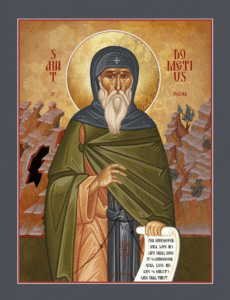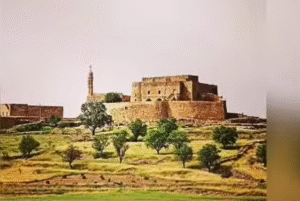St. Dimet (Dometius) of Persia – Sep 24

St. Dimet, Dometius (Domitius), is venerated as a martyr and saint, who lived in the fourth century and belonged to Persia during the reign of Constantine the Great. He was by tradition a Persian doctor but an idolater by religion. He like St Paul, is said to have persecuted many Christians early in his youth, before he was converted to Christ. The Persian religion could not satisfy his spiritual hunger and thirst and did not give him fulfillment and meaning to life, so he longed with all his soul to know the true God, Who did not overlook his prayer. The Lord arranged things so that he can come to know a Christian, who catechized him. He was catechized to the Faith by a Christian named Uaros (Abarus). Forsaking Persia, he withdrew to the frontier city of Nisibis (in Mesopotamia), where he was baptized, by Schabai in one of the monasteries, and received the monastic tonsure.
Fleeing the ill-will of some of the monks, St Dometius moved to the monastery of Saints Sergius and Bacchus in the city of Theodosopoulos. The monastery was under the guidance of an archimandrite abbot named Urbelos, a strict ascetic, of whom it was said that for sixty years he did not taste cooked food, nor did he lay down for sleep, but rather took his rest standing up, supporting himself upon his staff. He was ordained deacon and donned the monastic habit in the monastery. The archimandrite seeing his spiritual progress, suggested and decided to have him made a presbyter, but Dimet, considering himself unworthy, requested that he be allowed to complete his life as a simple monk. So, after receiving a blessing of the abbot, he left for a deserted place and ascended a desolate mountain in Syria, in the region of Cyrrhus and hid himself, and settled living in a cave, with two of his disciples. There he endured in extreme ascetical struggles, and he gave himself over with greater zeal to asceticism and prayer. He worked many miracles for those that came to him and converting many heathen unbelievers.
Stories about him constantly spread among the local inhabitants and people flocked to his retreat to request his blessings, help and to be healed. Many pagans were brought to faith in Christ by Dometius. Once, in the locality where Saint Dometius struggled with his disciples, the emperor Julian the Apostate (361-363) arrived, traveling on his campaign against the Persians. By order of the emperor, soldiers found St Dometius praying with his disciples in a cave and walled them up alive inside.
Emperor Julian, the Apostate, accused Dimet of courting popularity because Dimet had reproached Julian for his impiety. Dimet said: “If these poor harmless folk come to see me, I cannot send them away.” Julian was so enraged that he had Saint and his two disciples stoned to death as they were chanting the Sixth Hour.

He departed for heavenly abode on 24 September A.D. 362/408. In 478, a certain woman who was healed from her illness by Saint Dimet, took off the relics of the saint and had them transferred by bishop Theodore of Amid (Diyarbakir). Later, St. Joseph, a disciple of Bishop Theodore, built over the relics of St. Dimet a well-known and large monastery. In Germany in Hamburg-Neugraben there is a church dedicated to Saint Dimet, in Sweden in Jönköping there is a church of the Syrian Orthodox Church of Antioch . Several churches in Tur Abdin ( Taşköy , Izbirak), in Lebanon and a monastery in his place of activity Qelith (Killit) also bear his name.
There are two saints by the name Dimet (Dometius), that have many details in common including the date of commemoration, 24 September, but the year of death is differs – one in A.D. 362 and the other in A.D. 408
The feast of St. Dimet is celebrated in the Orthodox Syrian Church on 24 September and 7 August by Eastern Orthodox Churches.
0 Comments